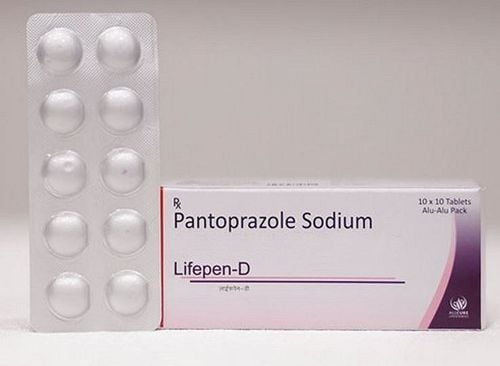This is an automatically translated article.
Omaza is an injectable drug, indicated for use in the treatment of reflux oesophagitis, gastric ulcer, duodenal ulcer or Zollinger-Ellison syndrome. To ensure the effectiveness of use when using Omaza, users need to follow the instructions of their doctor, and refer to more information about the use of Omaza in the following article.1. What is the use of Omaza?
1.1. What is Omaza? Omaza medicine has the main ingredient Omeprazole 40mg and excipients just enough. Omaza is a prescription drug, prepared in the form of lyophilized powder for intravenous injection, packaged in a box with 1 vial of 10ml. Omaza is a product of THE ACME LABORATORIES LTD. Address: Dhulivita, Dhamrai, Dhaka, Bangladesh. With registration number VN-19437-15, The Acme Laboratories Ltd. – Bangladesh
1.2. What does Omaza do? Omaza drug is used in the treatment of:
Diseases of reflux esophagitis. Mild duodenal and gastric ulcers include complications from taking nonsteroidal anti-inflammatory drugs (NSAIDs). Zollinger-Ellison syndrome (a medical condition caused by the formation of one or more tumors in the pancreas and duodenum, which secrete large amounts of the hormone gastrin, which stimulates the stomach to produce too much acid, leading to gastric and duodenal ulcers) and other diseases of increased gastric secretion.
2. Usage of Omaza
2.1. How to use Omaza drug Omaza drug for intravenous use:
Withdraw 10ml of water for injection from the vial of distilled water for injection and inject the whole into the powder vial, shake well to form a solution containing approximately 4mg Omeprazole per ml. After reconstitution, the solution for injection should be used within 04 hours from the time of preparation if stored at room temperature, in a dry place, protected from light. Injection method: When injecting, it is necessary to inject slowly, the shortest time is 2.5 minutes and the maximum rate is 4ml per minute.
2.2. Dosage of Omaza Stomach Ulcer, Duodenal Ulcer and Gastroesophageal Reflux: Take 40mg/time/day until it can be used orally. Zollinger-Ellison syndrome and other hypersecretory conditions: 80 mg initially, then increased to 160 mg, if the need for acid control increases rapidly. Use until it can be taken orally. 2.3 Contraindications Omaza is contraindicated in patients with hypersensitivity to Omeprazole, or benzimidazole derivatives.
Dealing with missed doses:
Usually Omaza can be used within 1 to 2 hours compared to the prescription prescribed. Unless there are strict rules about the time of use, the medicine can be taken within a few hours of the detection of forgetting. But if the time is too far from the time it should be used, it should not be used to compensate because it can be dangerous to the body. Patients need to strictly follow, or consult a specialist before making a decision. Treatment of Overdose:
There are no data on overdosage of Omaza in humans. A single intravenous dose of 80 mg, a daily intravenous dose of 200 mg, and a dose of 520 mg intravenously over a period of 3 days were well tolerated. Because omeprazole is strongly bound to plasma proteins, dialysis does not remove the drug. In case of overdose with clinical signs of toxicity, apart from symptomatic and supportive treatment, no specific treatment recommendations can be made.
3. Notes when using Omaza
Before administering omeprazole to patients with peptic ulcer disease, the possibility of malignancy must be excluded (the drug may mask symptoms and thereby delay diagnosis). Omaza should be injected intravenously in critically ill patients and those with multiple ulcers, to prevent bleeding from stress ulcers. It must be administered intravenously slowly for at least 3 minutes, and the maximum rate is 4 ml per minute. A dose of 40mg intravenously will immediately reduce the amount of acid hydrochloride (HCL) in the stomach within 24 hours. Solution for intravenous use after reconstitution must be used within 4 hours. Do not inject, if the solution has become discolored due to oxidation, or the solution contains a precipitate. Omeprazole 40mg for intravenous use, should only be used when the oral route is not suitable. Can be administered intravenously for 7 days. And switch to oral omeprazole as soon as possible instead of intravenous route. In patients with severe hepatic impairment, during treatment with omeprazole, it is necessary to regularly monitor liver enzymes and especially when using long-term. In case of elevated liver enzymes, the patient should stop taking the drug. Like all proton pump inhibitors, Omaza can increase the amount of bacteria in the upper gastrointestinal tract. Treatment with omeprazole may lead to a slightly increased risk of gastrointestinal infections caused by bacteria such as Salmonella and Campylobacter. Pregnant women: Although experimentally, omeprazole has not been found to have the potential to cause malformations or toxicity to the fetus, it is still not recommended for pregnant women, especially in the first 3 months. Lactation: Patients should not take omeprazole. To date, no research literature has come to a specific conclusion on this issue. Omaza side effects such as dizziness or drowsiness and visual disturbances may occur. Patients taking medication should not drive or operate machinery.
4. Omaza side effects
At therapeutic doses, Omaza is well tolerated. However, during the use of Omaza, patients may still experience side effects such as:
Common, ADR more than 1 in 100:
Body as a whole: Headache or drowsiness and dizziness. Gastrointestinal: Diarrhea, nausea, vomiting, abdominal pain, constipation and bloating. Uncommon, 1 in 1,000 less than ADR less than 1 in 100:
Neurological: Insomnia and sensory disturbances and fatigue. Skin: Urticaria, itching and rash. Liver: Transient elevation of transaminases. Rarely, ADR less than 1/1 000:
Systemic: Sweating and peripheral edema or hypersensitivity including angioedema and anaphylaxis. Hematologic: Leukopenia, thrombocytopenia, and total cytopenias, agranulocytosis and autoimmune hemolytic anemia. Neurological: Reversible confusion or agitation, depression and hallucinations in elderly patients and especially in critically ill or hearing impaired patients. Endocrine: Enlarged breasts in men. Gastrointestinal: Gastritis, or Candida infection and dry mouth. Liver: Hepatitis with or without jaundice, encephalopathy - liver disease in people with liver failure. Respiratory: Bronchospasm. Musculoskeletal: Joint pain, muscle pain. Urinary, genitourinary: Interstitial nephritis. If you experience these symptoms, the patient should stop using Omaza and notify the doctor for appropriate treatment.
5. Omaza drug interactions
Omeprazole has no clinically important interactions when taken with food and alcohol, amoxicillin or bacampicillin, caffeine, lidocaine, quinidine, theophylline. The drug is also unaffected by concomitant use of metoclopramide. Omeprazole is a medicine that can increase blood levels of cyclosporin. Omeprazole increases the effectiveness of antibiotics that eradicate Helicobacter pylori. Omeprazole is an inhibitor of the metabolism of drugs metabolised by the cytochrome P450 enzyme system of the liver, and it may increase blood levels of diazepam, phenytoin and warfarin. The reduced metabolism of diazepam makes the drug's effects last longer. At a dose of 40 mg per day, omeprazole inhibited the metabolism of phenytoin and increased blood levels of phenytoin, but a much weaker interaction with omeprazole 20 mg per day. Omeprazole inhibits the metabolism of warfarin, but has little effect on bleeding time. Omeprazole may increase the anticoagulant effect of dicoumarol. Omeprazole reduces the metabolism of nifedipine by at least 20%, and may increase the effect of nifedipine. Clarithromycin inhibits the metabolism of omeprazole and doubles the concentration of omeprazole. To avoid interactions, before being prescribed Omaza, the patient should inform the doctor about the drugs they are using, including functional foods. The doctor will base on that to prescribe the appropriate Omaza.
6. How to store Omaza
Keep Omaza medicine at a temperature below 30°C, away from direct light. After reconstitution, the solution for injection should be used within 04 hours, and counting from the time of reconstitution if stored at room temperature, in a dry place, protected from light. The shelf life of Omaza medicine is 24 months from the date of manufacture. Keep out of reach of children and household pets. Above is all information about Omaza drug, patients need to carefully read the instructions for use, consult a doctor / pharmacist before using. Absolutely do not arbitrarily buy Omaza treatment at home because there may be unwanted side effects.
Please dial HOTLINE for more information or register for an appointment HERE. Download MyVinmec app to make appointments faster and to manage your bookings easily.













